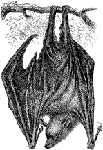

|
|
Rabies death a reminder of need for caution around bats
 A 9-year-old boy who died recently of bat rabies is the first reported victim of human rabies in Canada since 1985 (CCDR 2000;26[24]:209-11). The case is a reminder to physicians that Canadian immunization guidelines recommend postexposure prophylaxis for anyone who has slept unattended in a room where a bat is present, even in the absence of evidence of a bite (National Advisory Committee on Immunization. Canadian Immunization Guide. 5th edition. Ottawa: Health Canada; 1998:149-56).
A 9-year-old boy who died recently of bat rabies is the first reported victim of human rabies in Canada since 1985 (CCDR 2000;26[24]:209-11). The case is a reminder to physicians that Canadian immunization guidelines recommend postexposure prophylaxis for anyone who has slept unattended in a room where a bat is present, even in the absence of evidence of a bite (National Advisory Committee on Immunization. Canadian Immunization Guide. 5th edition. Ottawa: Health Canada; 1998:149-56).
The boy, who was staying with his parents at a cottage in the Laurentian Mountains north of Montreal, slept in a bedroom with his brother. On Aug. 28, 2000, bats were discovered in the bathroom and kitchen. They were removed by the father, who in one case used his bare hands to capture a bat. About 3 days later the boy showed his mother an erythematous lesion on his arm that had a small central laceration. The boy was well until Sept. 22, when he awoke feverish with pain in his arm. Despite supportive care, rabies immune globulin and vaccination, he died Oct. 6. Viral strains of bat rabies cause most human cases of rabies in North America. People sleeping in a room where a bat is discovered should be vaccinated immediately against rabies unless a bite can be reasonably excluded. Physicians should be aware that many bites do not leave marks (Hoey J, Todkill A. Bat rabies after undetected exposure: implications for prophylaxis. In this case, prophylaxis was given to 27 health care workers at the first hospital where the patient was treated and to 17 workers at the second hospital. It was given because of possible percutaneous or mucous membrane exposure to the patient's saliva. Twelve close playmates for whom exposure to the boy's saliva could not be ruled out also received prophylactic vaccination. The boy is the 22nd Canadian to die of rabies since 1925. — CMAJ
Copyright 2001 Canadian Medical Association or its licensors |